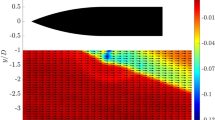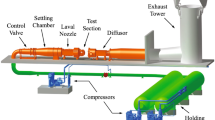Abstract
Experiments were performed within the Rutgers University Mach 3.4 supersonic wind tunnel to quantify the turbulent boundary layer in the test section, using stereoscopic particle image velocimetry (SPIV). Seeding of the tunnel was accomplished using atomized mineral oil, resulting in a Stokes number of 0.09. The Reynolds number based on momentum thickness and the friction-velocity Reynolds number were 64,000 and 4320, respectively, marking this as a high Reynolds number boundary layer. SPIV measurements were capable of resolving the mean velocity profile, along with turbulence quantities, permitting comparison against the known literature. Furthermore, the convection of vorticity concentrations representing hairpin vortices was observed within instantaneous vector fields. The resulting Reynolds stresses demonstrate that the boundary layer had typical values of anisotropy, while comparing well with data obtained within a slightly adverse pressure gradient. This was particularly noticeable from the trends in the Reynolds stresses, which exhibited higher-than-expected peak levels. These data provide a unique measurement of a supersonic turbulent boundary layer at Reynolds numbers not often encountered within existing data sets.
Graphic abstract








Similar content being viewed by others
References
Adrian RJ (2007) Hairpin vortex organization in wall turbulence. Phys Fluids 19:041301
Adrian RJ, Meinhart CD, Tomkins CD (2000) Vortex organization in the outer region of the turbulent boundary layer. J Fluid Mech 422:1–54
Aubertine CD, Eaton JK (2005) Turbulence development in a non-equilibrium turbulent boundary layer with mild adverse pressure gradient. J Fluid Mech 532:345–364
Beresh SJ, Henfling JF, Spillers RW, Pruett BOM (2011) Fluctuating wall pressures measured beneath a supersonic turbulent boundary layer. Phys Fluids 23:075110
Beresh SJ, Kearney SP, Wagner JL, Guildenbecher DR, Henfling JF, Spillers RW, Pruett BOM, Jiang N, Slipchenko MN, Mance J, Roy S (2015) Pulse-burst PIV in a high-speed wind tunnel. AIAA Paper No 2015-1218
Beresh SJ, Henfling JF, Spillers RW (2019) Time-resolved planar velocimetry of the supersonic wake of a wall-mounted hemisphere. AIAA J 57(4):1383–1399
Blackwelder RF, Kaplan RE (1976) On the wall structure of the turbulent boundary layer. J Fluid Mech 76:89–112
Bowersox RDW (1996) Combined laser doppler velocimetry and cross-wire anemometry analysis for supersonic turbulent flow. AIAA J 34(11):2269–2275
Brooks JM, Gupta AK, Smith MS, Marineau EC (2018) Particle image velocimetry measurements of Mach 3 turbulent boundary layers at low Reynolds numbers. Exp Fluids 59:83
Cebeci T, Smith AMO (1974) Analysis of turbulent boundary layers. Academic Press, New York
Coles D (1956) The law of the wake in the turbulent boundary layer. J Fluid Mech 1:191–226
Coles DE (1962) The turbulent boundary layer in a compressible field. Technical Report R-403-PR, Append A
DeMauro EP, Beresh SJ, Casper KM, Wagner JL, Henfling JF, Spillers RW (2019) Volumetric velocimetry of complex geometry effects on transonic flow over cavities. AIAA J 57(5):1941–1954
Dogariu LE, Dogariu A, Miles RB, Smith MS, Marineau EC (2018) Non-intrusive hypersonic freestream and turbulent boundary-layer velocity measurements in AEDC Tunnel 9 using FLEET. AIAA Paper No 2018-1769
Donovan JF, Spina EF, Smits AJ (1994) The structure of a supersonic boundary layer subjected to concave surface curvature. J Fluid Mech 259:1–24
Eagle WE, Driscoll JF (2014) Shock wave-boundary layer interactions in rectangular inlets: three-dimensional separation topology and critical points. J Fluid Mech 756:328–353
Ekoto I, Bowersox R, Goss L (2007) Boundary layers with curvature driven pressure gradients. AIAA Paper No 2007-1137
Elena M, Lacharme JP, Gaviglio J (1985) Comparison of hot-wire and laser Doppler anemometry methods in supersonic turbulent boundary layers. In: 2nd international symposium on laser anemometry
Elsinga GE, Adrian RJ, Van Oudheusden BW, Scarano F (2010) Three-dimensional vortex organization in a high-Reynolds-number supersonic turbulent boundary layer. J Fluid Mech 644:35–60
Fernando EM, Smits AJ (1990) A supersonic turbulent boundary layer in an adverse pressure gradient. J Fluid Mech 211:285–307
Fernholz HH, Finley PJ (1980) A critical compilation of compressible turbulent boundary layer data. AGARDograph 253
Ganapathisubramani B (2007) Statistical properties of streamwise velocity in a supersonic turbulent boundary layer. Phys Fluids 19:098108
Ganapathisubramani B, Clemens NT, Dolling DS (2006) Large-scale motions in a supersonic turbulent boundary layer. J Fluid Mech 556:271–282
Grinstein FF, Margolin LG, Rider WJ (2007) Implicit large eddy simulation: computing turbulent fluid. Cambridge University Press, New York
Humble RA, Scarano F, van Oudheusden BW, Tuinstra M (2006) PIV measurements of a shock wave/turbulent boundary layer interaction. In: 13th International symposium of laser techniques to fluid mechanics
Hutchins N, Nickels TB, Marusic I, Chong MS (2009) Hot-wire spatial resolution issues in wall-bounded turbulence. J Fluid Mech 635:103–136
Johnson DA, Rose WC (1975) Laser velocimeter and hot-wire anemometer comparison in a supersonic boundary layer. AIAA J 13(4):512–515
Kistler AL (1959) Fluctuation measurements in a supersonic turbulent boundary layer. Phys Fluids 2(1):290–296
Lapsa AP, Dahm WJA (2011) Stereo particle image velocimetry of nonequilibrium turbulence relaxation in a supersonic boundary layer. Exp Fluids 50(1):89–108
Lin H, ShiHe Y, YuXin Z, LiFeng T, Zhi C (2011) Experimental study of a supersonic turbulent boundary layer using PIV. Sci China Phys Mech 54(9):1702–1709
Lin H, ShiHe Y, LiFeng T, Zhi C, YangZhu Z (2013) Simultaneous density and velocity measurements in a supersonic turbulent boundary layer. Chin Phys B 22(2):024704
Marusic I, Mathis R, Hutchins N (2010a) High Reynolds number effects in wall turbulence. Int J Heat Fluid Flow 31:418–428
Marusic I, McKeon BJ, Monkewitz PA, Nagib HM, Smits AJ, Sreenivasan KR (2010b) Wall-bounded turbulent flows at high Reynolds numbers: recent advances and key issues. Phys Fluids 22:065103
McKeon BJ, Li J, Jiang W, Morrison JF, Smits AJ (2004) Further observations on the mean velocity distribution in fully developed pipe flow. J Fluid Mech 501:135–147
Melling A (1997) Tracer particles and seeding for particle image velocimetry. Meas Sci Technol 8:1406–1416
Monty JP, Harun Z, Marusic I (2011) A parametric study of adverse pressure gradient turbulent boundary layers. Int J Heat Fluid Flow 32:575–585
Morajkar RR, Klomparens RL, Eagle WE, Driscoll JF, Gamba M, Benek JA (2016) Relationship between intermittent separation and vortex structure in a three-dimensional shock/boundary layer interaction. AIAA J 54(6):1862–1880
Morkovin MV (1962) Effects of compressibility on turbulent flow. In: Favre A (ed) The mechanics of turbulence. Gordon and Breach, New York
Nagib HM, Chauhan KA (2008) Variations of von Karman coefficient in canonical flows. Phys Fluids 20:101518
Ojala DE (2012) Characterization of shock wave turbulent boundary layer interaction using particle image velocimetry. Master’s thesis, Rutgers University
Osterlund JM, Johansson AV, Nagib HM, Hites MH (2000) A note on the overlap region in turbulent boundary layers. Phys Fluids 12(1):1–4
Robinson SK (1991) The kinematics of turbulent boundary layer structure. NASA STI/Recon Technical Report N 91
Samimy M, Lele SK (1991) Motion of particles with inertia in a compressible free shear layer. Phys Fluids 3(8):1915. https://doi.org/10.1063/1.857921
Schreyer AM, Sahoo D, Smits AJ (2011) Experimental investigations of a hypersonic shock turbulent boundary layer interaction. AIAA Paper No 2011-0481
Smits AJ, Dussauge JP (2006) Turbulent shear layers in supersonic flows. Springer, New York
Smits AJ, Hayakawa K, Muck KC (1983) Constant temperature hot-wire anemometer practice in supersonic flows. Exp Fluids 1:83–92
Smits AJ, Spina EF, Alving AE, Smith RW, Fernando EM, Donovan JF (1989) A comparison of the turbulence structure of subsonic and supersonic boundary layers. Phys Fluids A 1(11):1865
Smits AJ, McKeon BJ, Marusic I (2011) High-Reynolds number wall turbulence. Annu Rev Fluid Mech 43:353–375
Spina EF, Donovan JF, Smits AJ (1991) On the structure of high-Reynolds-number supersonic turbulent boundary layers. J Fluid Mech 222:293–327
Urban WD, Mungal MG (2001) Planar velocity measurements in compressible mixing layers. J Fluid Mech 431:189–222
Vallikivi M, Hultmark M, Smits AJ (2015) Turbulent boundary layer statistics at very high Reynolds number. J Fluid Mech 779:371–389
van Driest ER (1951) Turbulent boundary layer in compressible fluids. J Aeronaut Sci 18(3):145–160
Vinuesa R, Orlu R, Vila CS, Ianiro A, Discetti S, Schlatter P (2017) Revisiting history effects in adverse-pressure gradient turbulent boundary layers. Flow Turbul Combust 99:565–587
Walz A (1969) Boundary layers of flow and temperature (English translation). MIT Press, Cambridge
Wang Q, Wang Z, Zhao Y (2016) On the impact of adverse pressure gradient on the supersonic turbulent boundary layer. Phys Fluids 28:116101
Wang Q, Wang Z, Zhao Y (2019) Impact of pure favorable pressure gradient on a supersonic flat-plate turbulent boundary layer. Acta Astronaut 154:67–73
Williams OJ, Smits AJ (2012) Application of PIV to the measurement of hypersonic turbulence. In: 16th International symposium of laser techniques to fluid mechanics
Williams OJH, Nguyen T, Schreyer A, Smits AJ (2015) Particle response analysis for particle image velocimetry in supersonic flows. Phys Fluids 27:076101
Yanta WJ, Gates DF, Brown FW (1971) The use of a laser Doppler velocimeter in a supersonic flow. No NOLTR-71-169 NAVAL ORDNANCE LAB WHITE OAK MD
Zahradka D, Parziale NJ, Smith MS, Marineau EC (2016) Krypton tagging velocimetryin a turbulent Mach 2.7 boundary layer. Exp Fluids 57:62
Zhang C, Duan L, Choudhari MM (2018) Direct numerical simulation database for supersonic and hypersonic turbulent boundary layers. AIAA J 56(11):4297–4311
Zhu Y, Yuan H, Zhang C, Lee C (2013) Image-preprocessing method for near-wall particle image velocimetry (PIV) image interrogation with very large in-plane displacement. Meas Sci Technol 24:125302
Acknowledgements
The authors would like to thank John Petrowski for his efforts in maintaining the SWT facility and for his advice in installing the smoke generator; Arastou Pournadali Khamseh, Mario Rivero, and Ramez Kiriakos for their help in running the wind tunnel; Professor Doyle D. Knight for providing his expertise on the subject; and Dr. Samantha Gildersleeve for helpful conversations. The authors gratefully acknowledge the Emil Buehler Perpetual Trust for their support of the Buehler Supersonic Wind Tunnel.
Author information
Authors and Affiliations
Corresponding author
Ethics declarations
Conflict of interest
The authors declare that they have no conflict of interest.
Additional information
Publisher's Note
Springer Nature remains neutral with regard to jurisdictional claims in published maps and institutional affiliations.
Rights and permissions
About this article
Cite this article
Panco, R.B., DeMauro, E.P. Measurements of a Mach 3.4 turbulent boundary layer using stereoscopic particle image velocimetry. Exp Fluids 61, 107 (2020). https://doi.org/10.1007/s00348-020-2941-9
Received:
Revised:
Accepted:
Published:
DOI: https://doi.org/10.1007/s00348-020-2941-9




